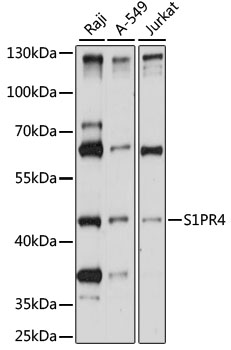Cell Biology Antibodies 5
Anti-S1PR4 Antibody (CAB15117)
- SKU:
- CAB15117
- Product Type:
- Antibody
- Reactivity:
- Human
- Host Species:
- Rabbit
- Isotype:
- IgG
- Antibody Type:
- Polyclonal Antibody
- Research Area:
- Cell Biology
Description
| Antibody Name: | Anti-S1PR4 Antibody |
| Antibody SKU: | CAB15117 |
| Antibody Size: | 20uL, 50uL, 100uL |
| Application: | WB |
| Reactivity: | Human |
| Host Species: | Rabbit |
| Immunogen: | A synthetic peptide corresponding to a sequence within amino acids 300 to the C-terminus of human S1PR4 (NP_003766.1). |
| Application: | WB |
| Recommended Dilution: | WB 1:500 - 1:2000 |
| Reactivity: | Human |
| Positive Samples: | Raji, A-549, Jurkat |
| Immunogen: | A synthetic peptide corresponding to a sequence within amino acids 300 to the C-terminus of human S1PR4 (NP_003766.1). |
| Purification Method: | Affinity purification |
| Storage Buffer: | Store at -20'C. Avoid freeze / thaw cycles. Buffer: PBS with 0.02% sodium azide, 50% glycerol, pH7.3. |
| Isotype: | IgG |
| Sequence: | SAVN PIIY SFRS REVC RAVL SFLC CGCL RLGM RGPG DCLA RAVE AHSG ASTT DSSL RPRD SFRG SRSL SFRM REPL SSIS SVRS I |
| Gene ID: | 8698 |
| Uniprot: | O95977 |
| Cellular Location: | Cell membrane, Multi-pass membrane protein |
| Calculated MW: | 41kDa |
| Observed MW: | 50kDa |
| Synonyms: | S1PR4, EDG6, LPC1, S1P4, SLP4 |
| Background: | This gene is a member of the endothelial differentiation, G-protein-coupled (EDG)) receptor gene family. EDG receptors bind lysophospholipids or lysosphingolipids as ligands, and are involved in cell signalling in many different cell types. This EDG receptor gene is intronless and is specifically expressed in the lymphoid tissue. |
| UniProt Protein Function: | S1PR4: Receptor for the lysosphingolipid sphingosine 1- phosphate (S1P). S1P is a bioactive lysophospholipid that elicits diverse physiological effect on most types of cells and tissues. May be involved in cell migration processes that are specific for lymphocytes. Belongs to the G-protein coupled receptor 1 family. |
| UniProt Protein Details: | Protein type:Membrane protein, integral; Receptor, GPCR; GPCR, family 1; Membrane protein, multi-pass Chromosomal Location of Human Ortholog: 19p13.3 Cellular Component: integral to plasma membrane; plasma membrane Molecular Function:G-protein coupled receptor activity; lipid binding Biological Process: G-protein coupled receptor protein signaling pathway; elevation of cytosolic calcium ion concentration; phospholipase C activation; immune response; G-protein signaling, adenylate cyclase activating pathway |
| NCBI Summary: | This gene is a member of the endothelial differentiation, G-protein-coupled (EDG)) receptor gene family. EDG receptors bind lysophospholipids or lysosphingolipids as ligands, and are involved in cell signalling in many different cell types. This EDG receptor gene is intronless and is specifically expressed in the lymphoid tissue. [provided by RefSeq, Jul 2008] |
| UniProt Code: | O95977 |
| NCBI GenInfo Identifier: | 42558945 |
| NCBI Gene ID: | 8698 |
| NCBI Accession: | O95977.1 |
| UniProt Secondary Accession: | O95977,D6W612, |
| UniProt Related Accession: | O95977 |
| Molecular Weight: | 41,623 Da |
| NCBI Full Name: | Sphingosine 1-phosphate receptor 4 |
| NCBI Synonym Full Names: | sphingosine-1-phosphate receptor 4 |
| NCBI Official Symbol: | S1PR4 |
| NCBI Official Synonym Symbols: | EDG6; LPC1; S1P4; SLP4 |
| NCBI Protein Information: | sphingosine 1-phosphate receptor 4; S1P receptor 4; S1P receptor Edg-6; endothelial differentiation G-protein coupled receptor 6; endothelial differentiation, G protein coupled receptor 6; endothelial differentiation, G-protein-coupled receptor 6; endothelial differentiation, lysophosphatidic acid G-protein-coupled receptor, 6; sphingosine 1-phosphate receptor Edg-6 |
| UniProt Protein Name: | Sphingosine 1-phosphate receptor 4 |
| UniProt Synonym Protein Names: | Endothelial differentiation G-protein coupled receptor 6; Sphingosine 1-phosphate receptor Edg-6; S1P receptor Edg-6 |
| Protein Family: | Sphingosine 1-phosphate receptor |
| UniProt Gene Name: | S1PR4 |
| UniProt Entry Name: | S1PR4_HUMAN |
View AllClose







